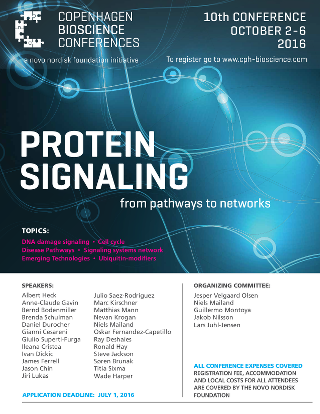This year I am once again involved in organizing an exclusive conference on protein signaling. There is no registration fee and accommodation is also free; all you have to pay yourself is your travel expenses.
Click the image to see the poster in full size.
This year we are fortunate to once again have an amazing lineup of invited speakers: Albert Heck, Anne-Claude Gavin, Bernd Bodenmiller, Brenda Schulman, Daniel Durocher, Gianni Cesareni, Giulio Superti-Furga, Ileana Cristea, Ivan Dickic, James Ferrell, Jason Chin, Jiri Lukas, Julio Saez-Rodriguez, Marc Kirschner, Matthias Mann, Nevan Krogan, Niels Mailand, Oskar Fernandez-Capetillo, Ray Deshaies, Ronald Hay, Steve Jackson, Søren Brunak, Titia Sixma, and Wade Harper.
Please note that although the poster says July 1, the application deadline is in fact June 20, which is only four days from now. To apply, please see the conference website.




